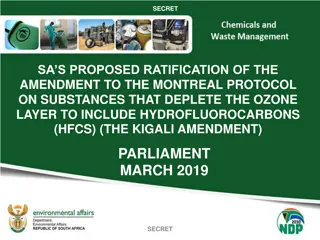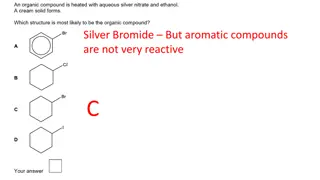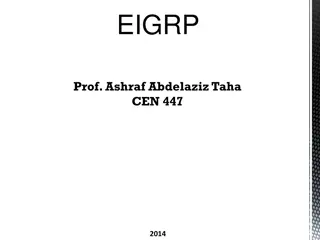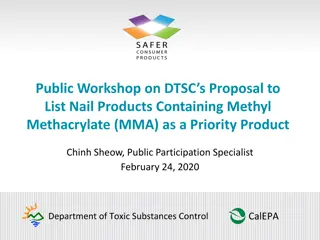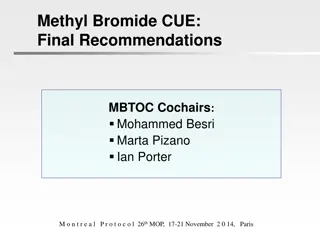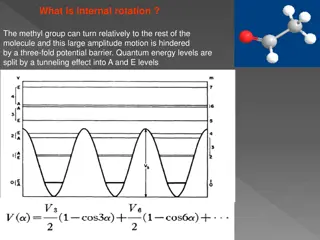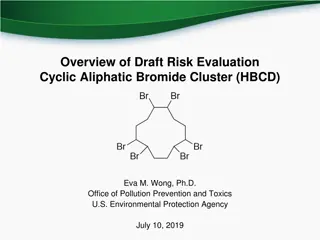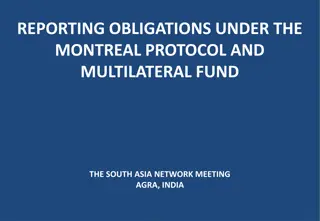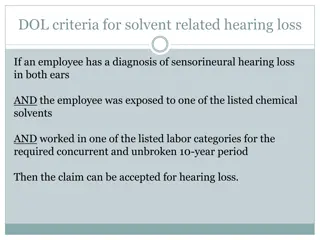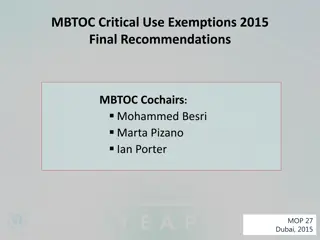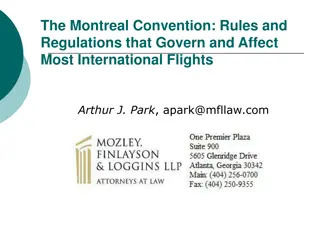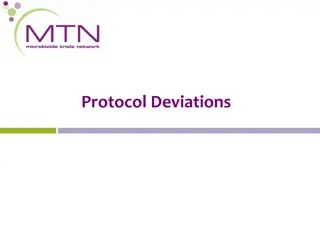Trends in Methyl Bromide Consumption and Recommendations from Montreal Protocol Meeting
Global trends show a significant decrease in Methyl Bromide (MB) consumption for controlled uses from 1991 to 2011. The Montreal Protocol Meeting in 2013 discussed final recommendations for Critical Use Nominations and other issues related to MB, including reporting of stocks and approved amounts for Critical Uses. The meeting also focused on recommendations for MB use in preplant soil applications for various countries and sectors for 2015.
Download Presentation

Please find below an Image/Link to download the presentation.
The content on the website is provided AS IS for your information and personal use only. It may not be sold, licensed, or shared on other websites without obtaining consent from the author.If you encounter any issues during the download, it is possible that the publisher has removed the file from their server.
You are allowed to download the files provided on this website for personal or commercial use, subject to the condition that they are used lawfully. All files are the property of their respective owners.
The content on the website is provided AS IS for your information and personal use only. It may not be sold, licensed, or shared on other websites without obtaining consent from the author.
E N D
Presentation Transcript
TEAP Methyl Bromide Technical Options Committee 1 Montreal Protocol, MOP 25, Bangkok, 21-25 October 2013
Final Recommendations for Critical Use Nominations, and Other Issues MBTOC Cochairs: Mohamed Besri Michelle Marcotte Marta Pizano Ian Porter Montreal Protocol, MOP 25, Bangkok, 21-25 October 2013
Global trends in MB consumption 1991 - 2011 60,000 50,000 40,000 MB (metric tonnes) Baseline non- A5 Baseline A 5 30,000 Consumption non-A5 Consumption A5 20,000 10,000 0 Global consumption for MB controlled uses has fallen from 64,420 t in 1991 to 5,187 t in 2011 Less than 1% of the aggregate baseline for MB in Non-A 5 Parties is now being requested for Critical Uses A5 Parties have phased out 80% of MB use in advance of the 2015 deadline
Reporting of Stocks (Dec IX/6 1,bii) MB stocks (t) reported at end of: 2005 0 3.7 48.1 10,417.0 10,592.7 2012 Australia Canada Japan USA Total 0 0.9 2.7 627.0 630.6 CUE recommendations are not adjusted to account for stocks Stocks reported by USA are twice the annual CUN request. Table 9.3 of the TEAP report also shows the amount of stocks used and authorised by Parties in 2012 4
Trends in Total MB amounts (t) approved for Critical Uses (2010-13) or nominated to 2015 4500 Switzerland USA TOTAL 3500 Australia Canada USA TOTAL 3235 3,863 2055 2,589 994 562 610 442 483 377 412 Only 3 non A5 Parties continue to submit nominations. The number of CUNs from non A5 Parties have diminished greatly from 116 in 2005 to 5 in 2013 No A5 CUN requests in 2013 4000 1,261 3000 2500 2000 1500 1000 500 0 2010 2011 2012 2013 2014 2015
MBTOC Soils Montreal Protocol, MOP 25, Bangkok, 21-25 October 2013
Final recommendations of MB for Preplant Soil Use (t) Country and Sector Nomination for 2015 Final recommendation for 2015 [28.765] Australia Strawberry runners Canada Strawberry runners USA Strawberry fruit TOTAL 29.760 5.261 [5.050] 373.660 [276.711] 408.681 310.526 Consensus was achieved on all nominations 7
CUN Final Recommendation: Australian Strawberry Nurseries Party Nomination for 2015 29.760 t MBTOC interim recommendation [0 t] [28.765 t] (3.4% reduction) MBTOC final recommendation Australia Strawberry Nursery 40 35 Methyl Bromide (t) Note: No significant reduction in the nomination since the CUN for 2009 30 25 20 15 10 5 0 2005 2006 2007 2008 2009 2010 2011 2012 2013 2014 2015 CUN 35.75 37.5 35.75 35.75 29.79 29.79 29.79 29.79 29.76 29.76 29.76 CUE 35.75 37.5 35.75 35.75 29.79 29.79 29.79 29.76 29.76 29.76 28.77
CUN Final Recommendation: Australian Strawberry Nurseries Party information after the OEWG: The Party provided an economic analysis for strawberry runner production in soil-less culture. The strawberry industry provided a new 3-year research plan to identify appropriate alternatives to MB. MBTOC: Acknowledges that the foundation stock stage in the strawberry runner production chain has already transitioned to soil-less production. Finds that an amount of 0.47 t is allocated each year by the Party for foundation stock. This is a contingency use and not recommended. Further considers that it is feasible to transition the mother plant stage (0.525 t) to soil-less production.
CUN Final Recommendation: Canadian Strawberry Nurseries Party Nomination for 2015 5.261 t MBTOC interim recommendation [5.050 t] MBTOC final recommendation [5.050 t] Canada Strawberry Nursery (PEI) 9 8 Methyl Bromide (t) 7 Note: No reduction in the nomination since the CUN for 2011 6 5 4 3 2 1 0 2006 2007 2008 2009 2010 2011 2012 2013 2014 2015 CUN 6.84 7.995 7.462 7.462 7.462 5.261 5.261 5.596 5.261 5.261 CUE 6.84 7.995 7.462 7.462 7.462 5.261 5.261 5.261 5.261 5.05
CUN Final Recommendation: Canadian Strawberry Nurseries Party Information after the OEWG: The Party stated that a groundwater study to reduce uncertainty over Pic use will now go ahead, The use of micro-propagated plants had reduced the feasibility of expansion to soil-less systems however they are commencing a study to determine the technical & economic feasibility of soil-less production. The Party confirmed that 2016 will be the final year for use of MB for this sector. MBTOC: MBTOC considers that soil-less systems/substrates are widely available to replace MB for the production of strawberry nursery plants and recommends a 4% reduction on the nominated amount.
CUN Final Recommendation: US Strawberry Fruit Party Nomination for 2015 373.660 t MBTOC interim recommendation [224.196 t] MBTOC final recommendation [276.711 t] USA Strawberry Fruit 3000 Methyl Bromide (t) 2500 2000 1500 1000 500 0 2005 2006 2007 2008 2009 2010 2011 2012 2013 2014 2015 CUN 2469 1918 1734 1605 1337 1103 1023 754 531.7 415.1 373.7 CUE 2053 1731 1476 1350 1269 1007 812.7 678 415.1 415.1 276.7
CUN Final Recommendation: US Strawberry Fruit Party Information after the OEWG: The Party requested the full nomination be recommended while they determine if the higher use rates for Pic registered in 2013 are accepted by state and local authorities. The Party indicated 2016 would be the final CUN for this sector. MBTOC: Alternatives (1,3-D/Pic and Pic alone under newly permitted rates of up to 392 kg/ha) with or without barrier films can replace MB for specific CUN uses. Complete phase out of MB is now feasible. Due to present uncertainty on regulations on use of Pic at higher dosage rates, MBTOCs final recommendation allowed a three year time to transition. As the technologies to apply Pic are known, MBTOC considered a greater reduction could be achieved in 2015 than the 10% reduction made by the Party (10%) and recommended a lower amount of MB.
MBTOC Structures and Commodities Montreal Protocol, MOP 25, Bangkok, 21-25 October 2013
Final Recommendations for Postharvest CUNs for 2015 Country and Sector Nominated in 2013 (tonnes) Recommended for 2015 (tonnes) 3.240 [3.240] United States Dry cure pork 0.310 [0] United States Fresh dates Total 3.510 [3.240]
US Fresh Dates Party: Nominated 0.310 tonnes, a 4.6% decrease of the amount granted by the Parties last year for this application. MB was requested for dates for quick shipment. MBTOC: Not recommended. Technically effective, commercially available alternatives are available and the need for a three-day market window for the approximate 25% of the total harvest volume nominated was not substantiated by the Party.
US Dry Cure Pork Party:Nominated 3.240 tonnes for 2015, a reduction of 13.1% from the amount granted by the Parties for this use in 2014. Reduction will be achieved by improving fumigation efficiency. MBTOC:Recommended 3.240 tonnes. Extensive research has demonstrated a continued lack of success with possible alternatives particularly in killing mites. MBTOC made new research and pest management suggestions.
Report on Emergency Use of MB for Pasta in Canada Canada fumigated two pasta warehouses after finding phosphine resistant pests in packaged pasta. 4.74 tonnes MB for rice weevils. Canada followed their domestic emergency use protocol. First time phosphine resistant pests identified in Canada and it is important to stop their spread. MBTOC was asked to provide suggestions to avoid such events in the future.
MBTOC suggests methods to avoid the development of phosphine resistant pests A stringent IPM program managed by experienced and capable pest control operators is a necessary pre-requisite. First assess the pests present and then fumigate properly following fumigant label. Only fumigate facilities or structures of good gas tightness. Fumigants should not be used in facilities of poor gas tightness. If pest resistance is suspected, use quicker tests than the FAO method to allow for a more effective follow- up fumigation.
Other Issues Montreal Protocol, MOP 25, Bangkok, 21-25 October 2013
Workplan 2014 Tasks and actions Date Parties submit CUNs to Ozone Secretariat 24 January 2014 Nominations forwarded to MBTOC co-chairs and assessed by MBTOC 7 February 2014 MBTOC requests additional information from Parties where necessary 21 February 2014 Nominating Parties submit response to MBTOC March 2014 MBTOC meets to assess nominations March 2014 MBTOC co-chairs provide draft recommendations to TEAP, and these are further discussed during TEAP meeting. MBTOC finalises report April 2014 Secretariat posts finalised report on its website May 2014 34th OEWG - Bilateral discussions TBD 2014 MBTOC meets (or conducts email assessment according to feasibility and justification) TBD 2014 MBTOC final report posted by Secretariat after TEAP review TBD 2014 26th Meeting of the Parties TBD 2014
Important issues for Article 5 Parties 1 January 2015 is the phase out date for use of MB in Article 5 Parties. CUNs for 2015 must be submitted in January 2014. CUNs for 2016 may be submitted in January 2014 or January 2015. 22
QPS (Article 7 and Decision XXIII/5) MBTOC notes that 43 Parties to date have reported QPS consumption for 2012 totalling 8,665 t (Article 7). The QPS report (Dec XXIII/5) presented information from 34 Parties (including EU member states) on categories of use for QPS. Since the 2013 TEAP progress report, additional information has been received from 3 other Parties (US, Canada, Japan). Most Parties provided a detailed breakdown of QPS uses by category which provides a good basis for further analysis by MBTOC. As anticipated in XXIII/5 and in light of this information, Parties may wish to request MBTOC to undertake a trend analysis of MB consumption for the QPS sector









